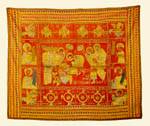|
|
| Church Embroidery |
1613/14 Docheiariou Monastery 96 x 114 cm Mount Athos workshop |
|

|
The main scene occupies the central section of this aer-epitaphios. The Virgin bends over the dead Christ, holding him in her arms, while Joseph holds his feet. Archangels, each with a double liturgical fan, stand at his head and feet. Behind this central group John stoops to kiss his hand. To the left stand four lamenting women, while Nikodemus, opposite them, raises his hand to his cheek. A tiny angel in the foreground swings a censer. Beneath Christ's feet is the inscription: 'ΧΕΙΡ ΕΥΤΕΛΟΥC ΚΑΛΛΗΝΙΚ(ΟΥ) / ΙΕΡΟΜΟΝΑ / ΧΟΥ / ΕΤΕΙ ΖΡΚΒ(' (by the hand of Kallinikos, hieromonk, in the year 1613/1614). The scene is framed by a narrow band inscribed with liturgical prayers of Symeon the Metaphrastis: 'Mortals, seeing the Lamb outstretched, with lowered gaze stand and tremble, for Christ is each day sacrificed within and all the ranks of the heavenly hosts surround him in awe whose broken body does feed the deserving but is as flames of fire to the undeserving). A broad border surrounds this inscription; in the four corners, the symbols of the four Evangelists, to the left of the central scene David and Daniel, to the right Solomon and Isaiah, above seraphs, and below wheels (thrones) between which are the words of the dedicatory inscription: 'ΑΝΑΘΗ-ΜΑ ΕΚΩ - ΜΕΙCΑ - ΙΟ(Υ)ΛΙ/ΑΝΗ (μον)αχ(η)/ΕCΤΙ ΔΕ ΚΛΗΡΟC ΜΟΝΗC - ΤΩΝ ΑCΟΜΑ/ΤΩΝ ΔΟΧΙΑΡΙΟΥ ΦΗ - ΜΗ ΤΩΝ ΕΝ ΤΩ ΑΘΩ' (Offered by Sister Iouliane / this is the property of the Monastery of the Archangels of Docheiariou, celebrated among those on Athos). Two iconographic themes are developed here: the symbolic representation of the sacrificed Lamb with the angelic hosts, the symbols of the Evangelists and the liturgical inscription, and the Lamentation. As we know, the icon of the epitaphios, derived from the representation of Christ the Lamb that decorated the original aer. The eucharistic image of the dead Christ between worshipping angels is known from as early as the twelfth century. In time the representation of the Lamb gradually became amalgamated with that of the Lamentation, both of which had the figure of the dead Christ as their focal point. In this epitaphios the central scene successfully merges the liturgical and the historical aspects of the subject, just as all the figures in the composition converge on the central horizontal axis formed by the recumbent body of Christ, giving the whole a predominantly hieratical character. Nevertheless, two elements give rise to a certain perplexity with regard to the date of this work: these are the presence of the tiny angel with the censer in the foreground, and the fusion of the double wheels into a single circle, with the fourth feather, normally in the overlapping section, here simplified into a rosette. Kallinikos, whose work is encountered in the Simonopetra pyle (1627), is also known from a third signed piece, the pyle with the representation of the 'Prophets from above' in the Monastery of Koutloumousiou, made in 1616/17 and restored in 1872 (Theocharis 1963 (1)). It had been suggested that the embroiderer probably belonged to the Meteora workshop (Theochari 1977), whose existence 'on the pinnacle of Barlaam' is confirmed by the inscription on an epitaphios from 1608. However, Kallinikos must surely be associated with Mount Athos, given the iconographic affinity with an epitaphios in the Boston Museum of Fine Arts and another in the Meteora Monastery of the Transfiguration. This epitaphios is embroidered on a length of orange silk. The flesh on the figures and all other places where purity of colour was important are worked in coloured silks and gold and silver thread, using a kavaliki stitch. The large surfaces of the garments are worked in gold and silver wire in kamares and bakladoti. The brightness of the colours in the women's mantles, the scrolls and gospels, as well as in certain other details, suggest that the epitaphios has been retouched.
| |
|
Bibliography: Ktenas 1930, p. 127, fig. 82. Theochari 1963 (1), pp. 498-9.
| ||
| M. Th. | ||
| Index of exhibits of Monastery of Docheiareiou 17th century |
||
Reference address : https://www.elpenor.org/athos/en/e218ck21.asp